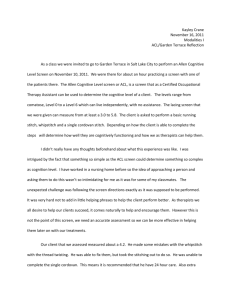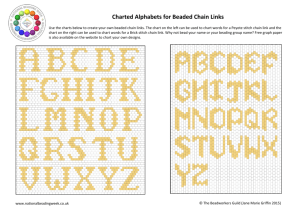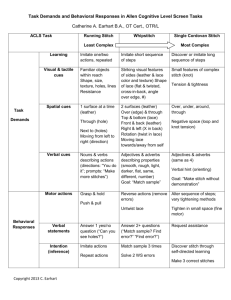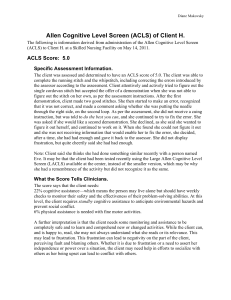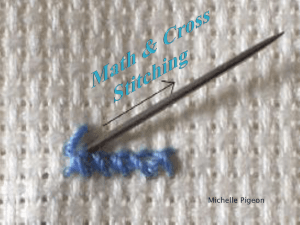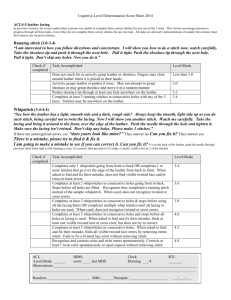Canadian Occupational Performance Measure
advertisement
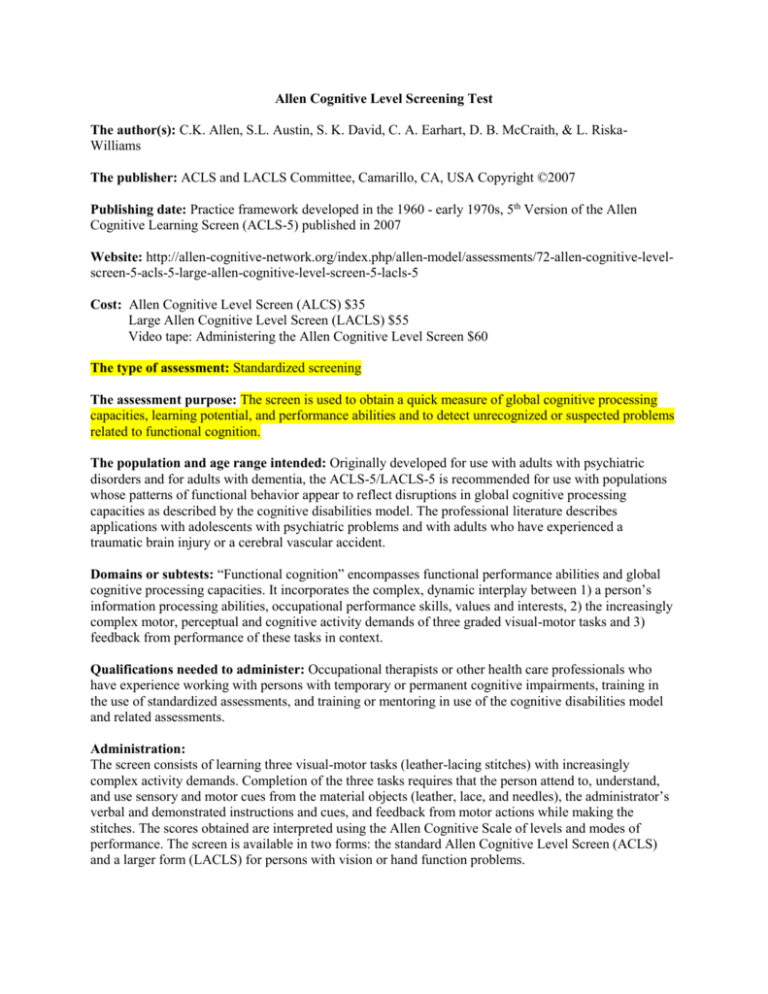
Allen Cognitive Level Screening Test The author(s): C.K. Allen, S.L. Austin, S. K. David, C. A. Earhart, D. B. McCraith, & L. RiskaWilliams The publisher: ACLS and LACLS Committee, Camarillo, CA, USA Copyright ©2007 Publishing date: Practice framework developed in the 1960 - early 1970s, 5th Version of the Allen Cognitive Learning Screen (ACLS-5) published in 2007 Website: http://allen-cognitive-network.org/index.php/allen-model/assessments/72-allen-cognitive-levelscreen-5-acls-5-large-allen-cognitive-level-screen-5-lacls-5 Cost: Allen Cognitive Level Screen (ALCS) $35 Large Allen Cognitive Level Screen (LACLS) $55 Video tape: Administering the Allen Cognitive Level Screen $60 The type of assessment: Standardized screening The assessment purpose: The screen is used to obtain a quick measure of global cognitive processing capacities, learning potential, and performance abilities and to detect unrecognized or suspected problems related to functional cognition. The population and age range intended: Originally developed for use with adults with psychiatric disorders and for adults with dementia, the ACLS-5/LACLS-5 is recommended for use with populations whose patterns of functional behavior appear to reflect disruptions in global cognitive processing capacities as described by the cognitive disabilities model. The professional literature describes applications with adolescents with psychiatric problems and with adults who have experienced a traumatic brain injury or a cerebral vascular accident. Domains or subtests: “Functional cognition” encompasses functional performance abilities and global cognitive processing capacities. It incorporates the complex, dynamic interplay between 1) a person’s information processing abilities, occupational performance skills, values and interests, 2) the increasingly complex motor, perceptual and cognitive activity demands of three graded visual-motor tasks and 3) feedback from performance of these tasks in context. Qualifications needed to administer: Occupational therapists or other health care professionals who have experience working with persons with temporary or permanent cognitive impairments, training in the use of standardized assessments, and training or mentoring in use of the cognitive disabilities model and related assessments. Administration: The screen consists of learning three visual-motor tasks (leather-lacing stitches) with increasingly complex activity demands. Completion of the three tasks requires that the person attend to, understand, and use sensory and motor cues from the material objects (leather, lace, and needles), the administrator’s verbal and demonstrated instructions and cues, and feedback from motor actions while making the stitches. The scores obtained are interpreted using the Allen Cognitive Scale of levels and modes of performance. The screen is available in two forms: the standard Allen Cognitive Level Screen (ACLS) and a larger form (LACLS) for persons with vision or hand function problems. Running Stitch: "I am interested in seeing how you follow directions and concentrate. I will show you how to do a stitch now, so watch carefully what I do." The administrator holds the leather with running stitch at top edge so that it is facing both the administrator and the person. Hold the leather in front of the person so that both sides of the leather can be seen. "Take the needle and push it down through the next hole and pull the thread through the hole. Push the needle up through the next hole. Pull the needle through the hole and tighten it. Don't skip any holes. Now you do it." Hand the leather and the needle to the person. These verbal directions and demonstrations can be repeated once if the person cannot complete the stitch on the first attempt. If the person stops before going through six holes, urge them to continue. If the person cannot complete the stitch after the second demonstration, thank them for participating and end the screening. If the person has trouble seeing the holes, try to anticipate the need for changing to the LACLS before giving the second demonstration. If you have to change to the LACLS, a third demonstration may be given. If errors are corrected or no errors are made, proceed to demonstrate the whipstitch. Interventions for errors – Running Stitch 1. "Is yours like mine?" "No." Go to step 3. If spontaneous fixing occurs, no further intervention may be required. 3. "How is it different?" Points to or names error. Go to step 5. Keep quiet if the person starts to fix it spontaneously. 5. "Can you fix it?" Attempts to fix by removing error and starting over. 2. "Yes" or no response to question of "Is yours like mine?" "You have a mistake. Can you find it? Show me where it is." 4. Does not identify error. "Your mistake is right here," while pointing to the error. "I want you to make yours look just like mine." 6. No attempt or an ineffective attempt to fix. "Would you like me to show you again?" Take out the error and start the demonstration over. Repeat the demonstration one time., If you think impairments (hand or vision) could explain the person’s difficulties, change to the LACLS now. Whipstitch: If the person is able to complete the running stitch, the administrator goes on to the whipstitch. The whipstitch verbal directions and demonstration can be repeated once if the person cannot complete the stitch on the first attempt. "See how the leather lacing has a dark, smooth side and a light, rough side." Check the person’s vision by looking at the person’s face and obtaining an acknowledgment to be sure that the person sees the two sides of the lacing. If they cannot see the two sides, switch to the LACLS. "Always keep the smooth, dark side up as you do each stitch, being careful not to twist the lacing. Now I will show you another stitch. Watch me carefully. Take the lacing and bring it around to the front, over the edge of the leather. Push the needle through the hole and tighten it. Be sure the lacing isn't twisted. Don't skip any holes. Now you do 3 stitches." If the person stops after one stitch ask the person to do at least 3 stitches by asking, "Can you do two more?" Two errors that are part of the rating criteria do not always occur: the cross in the back and twists in the lacing. When the problems do not occur, the errors should be introduced. If, however, the cross and/or twist do occur spontaneously, it is not necessary to repeat this/these problems. The instructions for introducing either of these problems are as follows: "I’m going to make a mistake to see if you can correct it." The administrator takes the ACLS and holds it to the left side to shield it from the person. On the backside of the ACLS, push the needle through the loop, trapping the lacing underneath the loop. This forms a cross in back of the ACLS. Hand the ACLS back to the person. "Can you show me my mistake?" "Can you fix it?" If the person can point out and correct the cross error, demonstrate the twist. The administrator takes the ACLS and introduces a twist in the last stitch. Make the twist clearly visible. Hand the ACLS back to the person."I have made another mistake." "Can you show me my mistake?" "Can you fix it?" If the person starts to correct the twist by taking the stitch out, stop the person. Ask "Can you do it without taking the lacing out of the hole?" Interventions for Errors - Whipstitch As soon as a mistake is made, prompt to determine if the person can correct the error. The person should not continue to do more stitches with an error in a previous stitch. The following prompts and interventions can be used: 1. "Is yours like mine?""No." Go to step 3. If spontaneous fixing occurs, no further intervention may be required. 3. "How is it different?" Points to or names error. Go to step 5. Keep quiet if the person starts to fix it spontaneously. 5. "Can you fix it?" Attempts to fix by removing error and starting over. 2. "Yes" or no response to question of "Is yours like mine?" "You have a mistake. Can you find it? Show me where it is." If the error is on the back, wait to see if the person can locate the error spontaneously. If you are holding the leather for the person, do not turn it over to show the person the error on the back until the person asks you to do so. 4. Does not identify error."Your mistake is right here,"while pointing to the error. "I want you to make yours look just like mine." 6. No attempt or an ineffective attempt to fix. "Would you like me to show you again?" Take out the error and start the demonstration over. Repeat the demonstration one time. If you think impairments (hand or vision) could explain the person’s difficulties, change to the LACLS now. Do not provide a third demonstration with the LACLS A whipstitch cross and twist cannot be scored if visual impairments or language comprehension are alternative explanations for being unable to do this part of the screen. Scores of 4-0 to 4.4 can be confounded by these factors. When in doubt, continue the screen by going on to the single cordovan stitch. If the person scores 4.2 or 4.4 on the whipstitch, proceed to the single cordovan stitch. If the person scores 4.0 or lower, stop the screen. When there is a discrepancy between the whipstitch and single cordovan stitch, score the highest score. Single Cordovan Stitch: The task difficulty jumps from an ACL 4.4 demand to an ACL 5.8 demand when the single cordovan is introduced. The jump occurs as an outcome of creating an opportunity to observe learning without a demonstration. Hand the leather to the person and point to this stitch. "Can you do this stitch by yourself?" An immediate response of panic, frustration, or a refusal to try to figure out how to do the stitch is an indication that the problem is too hard for the individual. Offer assistance by asking if the person would like a demonstration. Anytime that the person looks lost, frustrated, or in danger of quitting, offer a demonstration. Only two demonstrations can be scored. Provide verbal and demonstrated directions simultaneously: "Would you like to be shown how?" If so, continue: "Watch me carefully. Bring the needle to the front of the leather. Push the needle through the next hole towards the back of the leather. Don't pull the lacing tight but leave a small loop in it. Bring the lacing to the front of the leather. This time put the needle through the loop you have made. Keep the needle to the left of the lacing. (Show the insertion of the needle)Pull the lacing through the loop towards the back of the leather. Tighten the lacing from the back hole, then tighten the long lacing end. Make sure the lacing isn't twisted. Now you do 3 stitches." The administrator’s response to the person’s comments should be as non-directive as possible. If the person asks if he/she is doing it right, say "What do you think?" or "Is yours like mine?" or "Keep trying"- If the person says "that's not right", say "Can you fix it?" or "Can you show me what is wrong?" When a demonstration has not been provided and after a few minutes of attempting to do the stitch, a verbal cue may be provided: "Would you like some help?" If so, give a verbal cue with one piece of information such as "You have the first part right" or "Go from front to back". If that does not help, try pointing out the error. Allow time for the person to try to figure it out. This is not a timed screen. If the verbal cue does not improve performance, offer a demonstration. Offer a second demonstration when the same mistake is made over and over again or when no improvement in performance is observed. No more that 2 demonstrations can be scored. A few people may insist on a third demonstration, which may be provided but the third demonstration is not scored. Make sure that the person does 3 stitches. Some people get lucky and do 2 stitches but have not really learned how to do the stitch. Scoring methods: Scores range from 3.0-5.8 Running Stitch 3.0 Grasps leather or pushes it away. May not attempt to grasp the lacing or may grasp the leather lacing when handed to the person and moves leather lacing in a random manner. 3.2 Pushes needle through at least one hole, which can be the wrong location. May skip holes. 3.4 Completes at least 3 running stitches with no more than two demonstrations. Does not skip holes. Whipstitch 3.6 Does at least one whipstitch in the correct location; no skipped holes. 3.8 Does not recognize twist, cross errors in back when cued. Does recognize running stitch error, but is unconcerned about error. May continue until out of space. May say, "Am I done?" 4.0 Does recognize twists or the cross in back as an error when pointed out. Does not attempt to correct twist or cross errors. Corrects running stitch errors on back when pointed out. 4.2 Corrects twists by redoing the last stitch. Does not untwist while lacing is still in the hole. Corrects errors in cross in back. 4.4 Can untwist at least one whipstitch without pulling it out. Stops after 3 stitches. Single Cordovan Stitch 5.8 Completes 3 single cordovan stitches without a demonstration or a verbal cue by examining the sample stitches and using trial and error. 5.6 Completes 3 single cordovan stitches without a demonstration but requires a cue (verbal or pointing to location of error) to do the stitch correctly. 5.4 One (but only one) demonstration is given. Corrects errors in directionality, tangled lacing, or tightening in sequence without a second demonstration by altering actions two or more times. The following scores are after Second Demonstration is Given: 5.2 Corrects errors in directionality, tangled lacing, or tightening in sequence with a second demonstration. The loops are tightened in sequence; the tension may be a little loose but no other errors remain. 5.0 Corrects errors in directionality, tangled lacing, or tightening in sequence but cannot replicate solutions. A little improvement or alteration occurs with a second demonstration but errors remain. 4.8 Lacing is not tightened in sequence (hole then loop), just pulls on needle, may or may not recognize error. Little to no improvement is noted with first or second demonstration. 4.6 Right/left orientation of lacing and needle are incorrect when going through the loop. Little to no improvement is noted with first or second demonstration. 4.4 Goes from front to back through the hole (like the whipstitch) but inserts needle through loop from the back as if it were one step. (Lacing is under loop but does not wrap around it.) Or, directionality goes front to back through the hole but back to front through the loop or vice versa. Does not benefit from first and second demonstration. 4.2 Repeats the whipstitch or does the whipstitch followed by an attempt to do a second unrelated step. Does not benefit from first and second demonstration. Psychometric properties: Reliability: Inter-rater reliability has always been high. The original six cognitive levels were used in the first studies that found nearly perfect inter-rater reliability (r - .99, N = 32, range of levels 2-6). Newman (1989 examined the next version of the ACLS and found a percentage of agreement between two raters of 95.2% (N = 21). Test-retest reliability for Newman's sample of chronic schizophrenic patients was r = .75 (N = 22, p. 01). Partida (1992) looked at the inter-rater reliability of the large and small ACL with a small sample (N = 4) and two raters, finding perfect reliability. Howell (1993) found similar inter-rater reliability with the most recent version of the small ACLS (r = .91, p<.0001, N = 20). Eight raters trained by Penny, Musser, and North (1995) achieved an impressive r = .98. Validity: At that time the ACLS was used to place clients in a groups that matched their score; the predictive validity was r =.76, N = 23 (Moore, 1978). The ACLS has been correlated with well-known instruments commonly used with a variety of diagnostic categories to check the validity of the scale. The idea that the scale measured the severity of a disability was first investigated with the Brief Psychiatric Rating Scale; the concurrent validity with the ACLS was r == .53 at admission and r = .43 at discharge (Moore, 1978). In another sample with a schizophrenic population, Newman (1987) found a correlation with the Global Assessment Scale (r = .46, p<.01, N - 34). The strength of the validity correlations was not great, suggesting that prior experience, motivation, social situations and underlying mental processes can have important influences on ADL. Usefulness for OT: Advantages: - saves time by quickly identifying occupational performance issues - easy to administer - assessment is completed in the least restrictive environment - two versions of the screening tool: standard and larger version (for those who have visual or hand problems) - clients have autonomy and control over therapy Disadvantages: - client might be frightened by the tests and may refuse to cooperate - clients may easily get bored - frustrating for clients who want OT’s to have control - many ranges for the grading scale References Allen, C.K. (2000, March 17). Allen cognitive level screen 2000. Retrieved from http://www.allen-cognitive-levels.com/acls.htm Allen, C.K., Austin, S.L., David, S.K., Earhart, C.A., McCraith, D.B. & Riska -Williams, L. (2007). Allen cognitive level screen-5 (acls-5)/large allen cognitive level screen-5 (lacls-5). Retrieved from http://allen-cognitive-network.org/index.php/allenmodel/assessments Allen, C.K., Austin, S.L., David, S.K., Earhart, C.A., McCraith, D.B. & Riska -Williams, L. (2007). Allen cognitive level screen-5 (acls-5) and large allen cognitive level screen-5 (lacls-5). Retrieved from http://www.allencognitivelevelscreen.org/web09ACLS -5Handoutpg2.pdf Allen, C.K. & Blue, T. (1998). Research. Retrieved from http://www.allencogadvisor.com/index.php/Relevant-Information/research.html Katz, Naomi. (1998). Cognition and occupation in rehabilitation. Retrieved from http://www.allencognitive-level.com/reseach.htm
